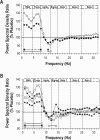EEG power spectra response to a 4-h phase advance and gaboxadol treatment in 822 men and women
- PMID: 22003345
- PMCID: PMC3190849
- DOI: 10.5664/JCSM.1316
EEG power spectra response to a 4-h phase advance and gaboxadol treatment in 822 men and women
Abstract
Study objective: To explore the effect of gaboxadol on NREM EEG in transient insomnia using power spectral analysis and evaluate the response between men and women.
Methods: This was a randomized, double-blind, 3-way, parallel-group transient insomnia study in 22 sleep laboratories. After a baseline night (N1), subjects underwent a 4-h phase-advance of their habitual sleep time the following night (N2). Healthy subjects aged 18-64 y were given single-blind placebo on N1 followed by double-blind treatment on N2 (gaboxadol 10 mg [n = 271], 15 mg [n = 274], or placebo [n = 277])
Results: At baseline, women showed significantly greater values in low frequency activity (< 10 Hz) and in high spindle/low beta frequency activity (14-18 Hz) compared to men. During the phase advance (placebo N2-baseline N1), there was a significant increase in power within the high spindle/low beta frequency range (15-17 Hz) and a significant reduction in beta activity (20-32 Hz), which was greater in women than men. Gaboxadol induced a significant (dose-related) increase in low frequencies (< 8 Hz) and a significant (dose-related) decrease within the alpha/spindle range (11-12 Hz). The effect was dependent upon sex, with a greater magnitude of effect observed in women than men.
Conclusion: Gaboxadol shows a characteristic NREM EEG spectral profile in a model of transient insomnia. Men and women show clear differences in NREM EEG activity at baseline, to gaboxadol treatment and to phase-shifts in habitual sleep/wake times. The exact mechanisms underlying the sex differences remain unclear, but sex is an important variable in studies evaluating sleep and gaboxadol. TRIAL REGISTRY INFORMATION:
Trial registry: www.clinicaltrials.gov, study identifier: NCT00102167.
Keywords: EEG power spectra; Gender differences; gaboxadol; slow wave sleep; transient insomnia.
Figures




Similar articles
-
The selective extrasynaptic GABAA agonist, gaboxadol, improves traditional hypnotic efficacy measures and enhances slow wave activity in a model of transient insomnia.Sleep. 2007 May;30(5):593-602. doi: 10.1093/sleep/30.5.593. Sleep. 2007. PMID: 17552374 Clinical Trial.
-
EEG spectral power density profiles during NREM sleep for gaboxadol and zolpidem in patients with primary insomnia.J Psychopharmacol. 2012 Aug;26(8):1081-7. doi: 10.1177/0269881111424457. Epub 2011 Nov 5. J Psychopharmacol. 2012. PMID: 22057018 Clinical Trial.
-
Efficacy of the selective extrasynaptic GABA A agonist, gaboxadol, in a model of transient insomnia: a randomized, controlled clinical trial.Sleep Med. 2008 May;9(4):393-402. doi: 10.1016/j.sleep.2007.06.006. Epub 2007 Aug 30. Sleep Med. 2008. PMID: 17765013 Clinical Trial.
-
Gaboxadol--a new awakening in sleep.Curr Opin Pharmacol. 2006 Feb;6(1):30-6. doi: 10.1016/j.coph.2005.10.004. Epub 2005 Dec 20. Curr Opin Pharmacol. 2006. PMID: 16368265 Review.
-
Neurochemical regulation of sleep.J Psychiatr Res. 2007 Oct;41(7):537-52. doi: 10.1016/j.jpsychires.2006.04.007. Epub 2006 Jun 13. J Psychiatr Res. 2007. PMID: 16777143 Review.
Cited by
-
Sex and Sleep Disruption as Contributing Factors in Alzheimer's Disease.J Alzheimers Dis. 2024;97(1):31-74. doi: 10.3233/JAD-230527. J Alzheimers Dis. 2024. PMID: 38007653 Free PMC article. Review.
-
Electroencephalographic power spectral density profile of the orexin receptor antagonist suvorexant in patients with primary insomnia and healthy subjects.Sleep. 2014 Oct 1;37(10):1609-19. doi: 10.5665/sleep.4068. Sleep. 2014. PMID: 25197807 Free PMC article. Clinical Trial.
-
Evaluating the evidence for sex differences: a scoping review of human neuroimaging in psychopharmacology research.Neuropsychopharmacology. 2022 Jan;47(2):430-443. doi: 10.1038/s41386-021-01162-8. Epub 2021 Nov 3. Neuropsychopharmacology. 2022. PMID: 34732844 Free PMC article.
-
Sex differences in the circadian regulation of sleep and waking cognition in humans.Proc Natl Acad Sci U S A. 2016 May 10;113(19):E2730-9. doi: 10.1073/pnas.1521637113. Epub 2016 Apr 18. Proc Natl Acad Sci U S A. 2016. PMID: 27091961 Free PMC article.
-
Periocular skin warming promotes body heat loss and sleep onset: a randomized placebo-controlled study.Sci Rep. 2020 Nov 23;10(1):20325. doi: 10.1038/s41598-020-77192-x. Sci Rep. 2020. PMID: 33230185 Free PMC article. Clinical Trial.
References
-
- Dijk DJ. Slow-wave sleep deficiency and enhancement: implications for insomnia and its management. World J Biol Psychiatry. 2010;11(Suppl 1):22–8. - PubMed
-
- Ebert B, Wafford KA, Deacon S. Treating insomnia: Current and investigational pharmacological approaches. Pharmacol Ther. 2006;112:612–29. - PubMed
Publication types
MeSH terms
Substances
Associated data
LinkOut - more resources
Full Text Sources
Medical

